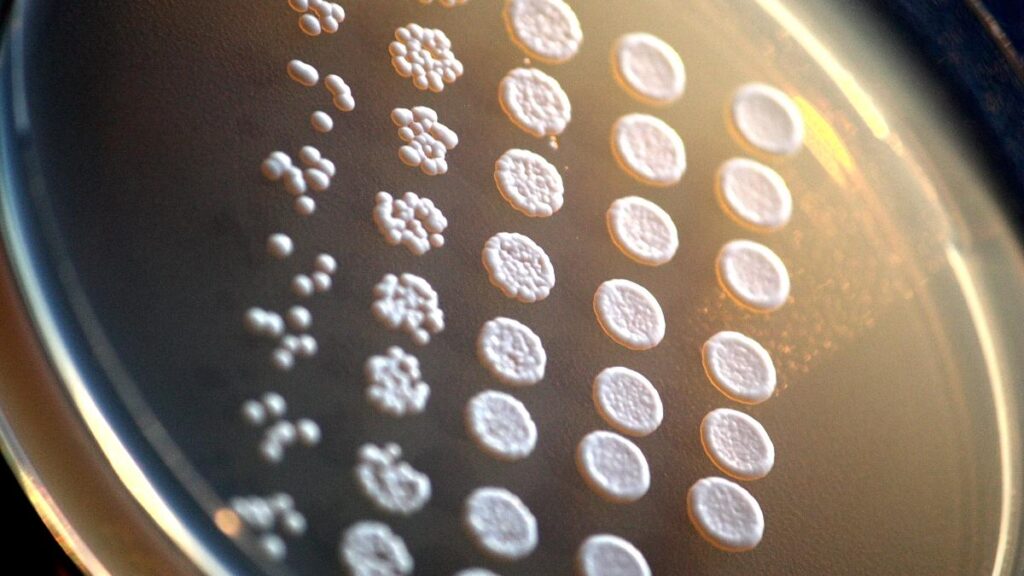
Yeast colonies being grown on an agar plate.
| Photo Credit: Rainis Venta (CC BY-SA)
Researchers at Emory University and the University of Texas Health Science Centre, both in the US, have found that a class of mutations that leads to serious developmental disabilities in human babies has similar effects in budding yeast, a simpler organism. The findings represent a major step in the study of these conditions because they throw light on how they ought to be studied.
Since yeast is easy to study in labs, they also raise the possibility of quickly testing drugs to treat these conditions in yeast first.

RNA exosomopathies
Pontocerebellar hypoplasia type 1 (PCH1) is a serious medical condition that presents at birth. Babies born with it have impaired development of two brain regions, the pons and the cerebellum. PCH1 patients show delayed development, diffuse weakness, problems with movement, and intellectual disability. Most don’t survive beyond infancy or early childhood.
In 2012, four siblings with PCH1 type B were all found to carry mutations in a gene called EXOSC3, which encodes one protein of a multiprotein complex in cells called the RNA exosome. This provided the first example of a human disease caused by mutations affecting the RNA exosome.
The RNA exosome was discovered in 1997 in budding yeast (Saccharomyces cerevisiae). Its primary job is to process, monitor, and turnover cellular RNA.
Subsequent studies of patients with other neurological and developmental disorders uncovered mutations in many other genes related to RNA exosome proteins. These conditions are together called RNA exosomopathies.
Most RNA exosomopathies lead to brain maldevelopment. A major question in the study of these proteins is which exosomopathies lead to which form of maldevelopment.
The RNA exosome
The new findings were reported in two papers this April, one in the journal RNA and the other inG3 Genes Genomes Genetics.
The RNA molecule is the working copy of the genes in our cells. The master copy is the DNA. A cell uses the DNA sequence corresponding to a gene as a template to make the RNA for that gene, then uses the RNA to make proteins. Many newly made RNAs are processed by the RNA exosome before they can play their cellular roles.

Most of the RNA in a cell is rRNA (ribosomal RNA). Other types are mRNA (messenger RNA), tRNA (transfer RNA), and various non-coding RNA (ncRNA).
After the mRNA is transcribed from a gene, it is attached to the ribosome, the cell’s protein-making factory. The factory’s ingredients supplier is the tRNA.
A critical function of the RNA exosome is to produce the mature rRNAs required to build functional ribosomes. The RNA exosome also degrades mRNA marked for removal.
Unique signatures
The RNA paper investigated how different disease-causing mutations in the RNA exosome have diverse cellular effects. To model the diseases, the researchers introduced mutations linked to human diseases into the corresponding four genes in yeast.
The researchers found that the mutations particularly affected the ncRNA, the mRNA involved in metabolism, and ribosomal protein genes. They were also able to confirm defects in the process cells use to make ribosomes.
Importantly, this study showed that different RNA exosomopathy mutations have unique molecular signatures that affect RNA surveillance, ribosome production, and protein synthesis. This distinctiveness explained the different clinical outcomes in patients with different RNA exosome mutations, and underscored the value of functional modelling to understand the conditions.
A humanised model
In the G3 paper, researchers reported creating a ‘humanised yeast model’ by replacing particular pieces of the yeast RNA exosome with their human or mouse counterparts. Of the nine core pieces, six could be replaced in this way; of these six, three still allowed the yeast to grow almost normally.

Then they mutated those genes in the model that were known to cause brain maldevelopment in humans. The model helped them identify the precise genetic variants that caused functional defects, including both previously known mutations and new ones.
In each case, the team was also able to show that the mutations directly disrupted the RNA exosome, rather than some intermediary process doing so.
This study established that the humanised yeast model is a convenient platform to test which human RNA exosome mutations are bad and which aren’t.
In sum, the studies showed that disease variants that damage RNA exosomes in humans also do so in yeast. It’s possible drugs found in the future to ameliorate damage in yeast may prove to be useful in humans as well.
D.P. Kasbekar is a retired scientist.
Published – May 11, 2025 06:00 am IST

